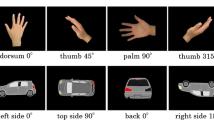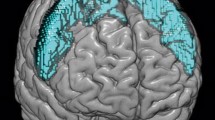Abstract
The purpose of this study was to show a gradient of possible bilateral activation for movements of the non-dominant vs. dominant hand, as well as for areas involved in complex vs. simple hand movements. A standard 1.5 T magnetic resonance imaging (MRI) system has been utilized to localize the cortical motor hand areas, using the blood oxygen level dependent contrast (BOLDc) technique and single-section fast low-angle shot (FLASH) imaging. Ten normal right-handed subjects volunteered for the study. The motor tasks consisted of simple (flexion-extension) finger movements of either hand, and complex movements (finger-to-thumb opposition in a repeating, pre-planned sequence) of the non-dominant hand.
Simple movements caused contralateral activation of the primary motor area (MA); ipsilateral activation was observed for the non-dominant hand only. Supplementary motor area (SMA) was also activated, with a clear contralateral prevalence. The ratio of bilateral activation of MA did not change with complex movements of the non-dominant hand, while SMA as well as lateral premotor area were largely bilaterally activated in this task. In conclusion, the ipsilateral MA is activated for movements — even simple — performed with the non-dominant hand. There is widespread functional activity, involving both contralateral and ipsilateral SMA, for complex movements.
Sommario
Scopo di questo studio è stato quello di dimostrare la possibile differenza di attivazione bilaterale per i movimenti delta mano non-dominants nei confronti di quella dominante come pure il diverso coinvolgimento delle aree corticali motorie durante l'esecuzione di movimenti complessi della mano rispetto ai movimenti semplici. È stato utilizzato un apparecchio standard di risonanza magnetica di 1,5 T, per tocalizzare le aree corticali motorie delta mano, utilizzando la tecnica BOLDc ed immagini FLASH a singola sezione. 10 soggetti destrimani sani sono stati utilizzati come volontari per to studio; gli stimoli motori consistevano nell'esecuzione di movimenti semplici (flesso-estensione delle dita) da parte sia delta mano dominante the di quella non dominante, e di movimenti complessi (opposizione delle 4 dita al pollice in maniera ripetuta secondo una sequenza stabilita, 2,4,3,5) da parte delta mano non-dominants.
L'esecuzione dei movimenti semplici ha determinato l'attivazione controlaterale dell'area motoria primaria (MA); attivazione ipsilaterale è stata osservata solo per la mano non dominante. Anche l'area supplementare motoria (SMA) è stata attivata, con chiara prevalenza per quella controlaterale. L'entità di attivazione bilaterale delta MA non cambiava con l'esecuzione di movimenti complessi, mentre la SMA, così come l'area premotoria laterale (LPA), erano maggiormente attivate in entrambi i lati con questo tipo di stimolo.
In conclusione, la MA ipsilaterale è attivata per movimenti — anche se semplici — eseguiti con la mano non-dominants; esiste una notevole attività funzionale, comprendente la SMA sia controlaterale che ipsilaterale, durante l'esecuzione di movimenti complessi.
Similar content being viewed by others
References
Roland PE, Larsen B, Lassen NA et al (1980) Supplementary motor area and other cortical areas in organization of voluntary movements in man. J Neurophysiol 43(1):118–136
Roland PE, Meyer E, Shibasaki Y et al (1982) Regional cerebral blood flow changes in cortex and basal ganglia during voluntary movements in normal human volunteers. J Neurophysiol 48(2):467–480
Woolsey CN, Erickson TC, Gilson WE (1979) Localization in somatic sensory and motor areas of human cerebral cortex as determined by direct recording of evoked potentials and electrical stimulation. J Neurosurg 51:476–506
Yang TT, Gallen CC, Schwartz BJ et al (1993) Noninvasive somatosensory homunculus mapping in humans by using a large-array biomagnetometer. Proc Natl Acad Sci USA 90:3098–3102
Kim SG, Ashe J, Georgopoulus AP et al (1993) Functional magnetic resonance imaging of motor cortex: Hemispheric asymmetry and handedness. Science 261:615–617
Rao SM, Binder JR, Bandettini PA et al (1993) Functional magnetic resonance imaging of complex human movements. Neurology 43:2311–2318
Le Bihan D (1996) Functional MRI of the brain. Principles, applications and limitations. J Neuroradiol 23:1–5
Fox PT, Raichle ME (1986) Focal physiological uncoupling of cerebral blood flow and oxidative metabolism during somatosensory stimulation in human subjects. Proc Natl Acad Sci USA 83:1140–1144
Turner R (1993) Functional mapping of the human visual cortex at 4 tesla and 1.5 tesla using deoxygenation contrast EPl. Magn Reson Med 29:277–279
Briggs GG, Nebes RD (1975) Patterns of hand preference in a student population. Cortex 11:230–238
Friston KJ, Ashburner J, Frith CD et al (1995) Spatial registration and normalization of images. Human Brain Mapping 3:165–189
Mattay VS, Frank JA, Santha AK et al (1996) Whole-brain functional mapping with isotropic MR imaging. Radiology 201:399–404
Baudendistel K, Schad LR, Wenz F et al (1996) Monitoring of task performance during functional magnetic resonance imaging of sensorimotor cortex at 1.5 T. Magn Reson Imaging 14(1): 51–58
Connelly A, Jackson GD, Frackowiak RS et al (1993) Functional mapping of activated human primary cortex with a clinical MRI imaging system. Radiology 188:125–130
Van Gelderen P, Ramsey NF, Liu G et al (1995) Three-dimensional functional magnetic resonance imaging of human brain on a clinical 1.5-T scanner. Proc Natl Acad Sci USA 92:6906–6910
Wiener E, Schad LR, Baudendistel K et al (1996) Functional MR imaging of visual and motor cortex stimulation at high temporal resolution using a flash technique on a standard 1.5 tesla scanner. Magn Reson Imaging 14(5):477–483
Kim JH, Shin T, Kim JS et al (1996) MR imaging of cerebral activation performed with a gradient-echo technique at 1.5 T: Sources of activation signals. AJR Am J Roentgenol 167:1277–1281
Lai S, Hopkins AL, Haacke EM et al (1993) Identification of vascular structures as a major source of signal contrast in high resolution 2D and 3D functional activation imaging of the motor cortex at 1.5 T: Preliminary results. Magn Reson Med 30(3):387–392
Bandettini PA, Jesmanowicz A, Wong EC et al (1996) Processing strategies for time-course data sets in functional MRI of the human brain. Magn Reson Med 30(2):161–173
Wiesendanger M (1981) The pyramidal tract. Its structure and function. In: Tow AL, Luchei ES (eds) Motor coordination. Handbook of behavioural neurobiology, 5th edn. Plenum, New York, pp 401–491
Lawrence DG, Kuypers HGJM (1968) The functional organization of the motor system in the monkey. I: The effects of bilateral pyramidal lesions. II: The effects of lesions of the descending brain-stem pathways. Brain 91:1–36
Yakolev PI, Rakic P (1966) Patterns of decussation of bulbar pyramids and distribution of pyramidal tracts on two sides of the spinal cord. Trans Am Neurol Assoc 91:366–367
Glees P, Cole J (1952) Ipsilateral representation in the cerebral cortex: Its significance in relation to motor function. Lancet 1:1191–1192
Nyberg-Hansen R, Rinvik E (1962) Some comments on pyramidal tract, with special reference to its individual variations in man. Acta Neurol Scand 39:1–30
Remy P, Zilbovicius M, Leroy-Villig A et al (1994) Movement- and task-related activations of motor cortical areas: A positron emission study. Ann Neurol 36:19–26
Colebatch JG, Deiber MP, Passingham RE et al (1991) Regional cerebral blood flow during voluntary arm and hand movements in human subjects. J Neurophysiol 65(6): 1392–1401
Cohen LG, Meer J, Tarka I et al (1991) Congenital mirror movements. Abormal organization of normal pathways in two patients. Brain 114:381–403
Brodal A (1973) Self-observations and neuro-anatomical considerations after stroke. Brain 96:675–694
Colebatch JG, Gandevia SC (1989) The distribution of muscular weakness in upper motor neuron lesions affecting the arm. Brain 112:749–763
Jones RD, Donaldson IM, Parkin PJ (1989) Impairment and recovery of ipsilateral sensory-motor function following unilateral cerebral infarction. Brain 112:113–132
Chollet F, Di Piero V, Wise RJS et al (1991) The functional anatomy of motor recovery after stroke in humans: A study with positron emission tomography. Ann Neurol 29:63–71
Gardner WJ (1993) Removal of the right cerebral hemisphere for infiltrating glioma. JAMA 101:823–826
Glees P (1980) Functional reoganization following hemispherectomy in man and after small experimental lesions in primate. In: Bach y Rita P (ed) Recovery of function: Theoretical considerations for brain injury rehabilitation. University Park, Baltimore, pp 106–126
Kimura D (1977) Acquisition of a motor skill after left-hemisphere demage. Brain 100:527–542
Li A, Yetkin Z, Cox R et al (1996) Ipsilateral hemisphere activation during motor and sensory tasks. AJNR Am J Neuroradiol 17:651–655
Boecker H, Kleinschmidt A, Requardt M et al (1994) Functional cooperativity of human cortical motor areas during self-paced simple finger movements. A high-resolution MRI study. Brain 117:1231–1239
Luppino G, Matelli M, Camarda RM et al (1991) Multiple representations of body movements in mesial area 6 and the adjacent cingulate cortex: An intracortical microstimulation study in the macaque monkey. J Comp Neurol 311:463–482
Matelli AU, Luppino G, Rizzolatti G (1991) Architecture of superior and mesial area 6 and the adjacent cingulate cortex in the macaque monkey. J Comp Neurol 22:445–462
Matsuzaka Y, Aizawa H, Tanji J (1992) A motor area rostral to the supplementary motor area (presupplementary motor area) in the monkey: Neuronal activation during a learned motor task. J Neurophysiol 68:653–662
Deiber MP, Passingham RE, Colebatch JG et al (1991) Cortical areas and the selection of movement: A study with positron emission tomography. Exp Brain Res 84:393–402
Larsson J, Gulyas B, Roland PE (1996) Cortical representation of self-paced finger movement. Neuroreport 7:463–468
Matelli M, Rizzolati G, Bettinardi V et al (1993) Activation of precentral and mesial motor areas during the execution of elementary proximal and distal arm movements: A PET study. Neuroreport 4:1295–1298
Author information
Authors and Affiliations
Rights and permissions
About this article
Cite this article
Beltramello, A., Cerini, R., Puppini, G. et al. Motor representation of the hand in the human cortex: an f-MRI study with a conventional 1.5 T clinical unit. Ital J Neuro Sci 19, 277–284 (1998). https://doi.org/10.1007/BF00713853
Received:
Accepted:
Issue Date:
DOI: https://doi.org/10.1007/BF00713853




